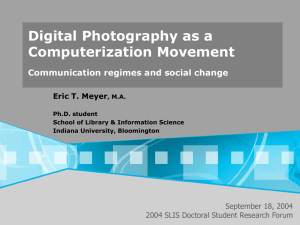Estimating Canadian Monetary Policy Regimes
advertisement
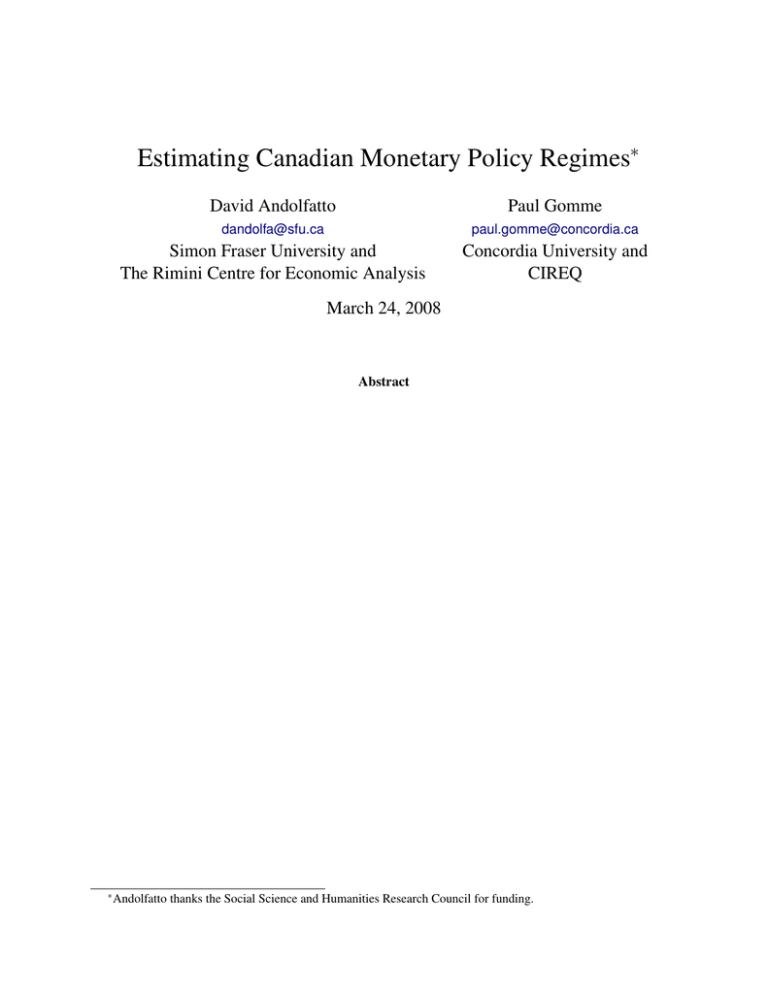
Estimating Canadian Monetary Policy Regimes∗
David Andolfatto
Paul Gomme
dandolfa@sfu.ca
paul.gomme@concordia.ca
Simon Fraser University and
The Rimini Centre for Economic Analysis
Concordia University and
CIREQ
March 24, 2008
Abstract
∗ Andolfatto
thanks the Social Science and Humanities Research Council for funding.
1
Introduction
In an earlier work (Andolfatto and Gomme, 2003), we argued that monetary policy in Canada might
be usefully described as a regime-switching process characterized by some degree of uncertainty
on the part of agents over the prevailing policy regime in place at any given time. Faced with this
uncertainty, agents are compelled to make inferences over the nature of monetary policy on the
basis of observables, such as historical money growth rates and any other relevant information. We
demonstrated that optimal learning behavior on the part of agents induces a sluggish adjustment in
belief formation, so that expectations naturally tend to lag the underlying reality (as in Muth, 1961).
We argued further that the endogenous propagation mechanism embedded in optimal learning
over uncertain regimes has quantitatively important effects and can go some way in explaining
the persistence in inflation expectations and interest rates following a change in monetary policy
regime.
In this paper, we are concerned with investigating the sensitivity of our previous results to
some restrictive assumptions made there in estimating policy regimes. In particular, our earlier
paper restricts monetary policy to follow a two-state regime-switching process, with each regime
characterized primarily by the underlying ‘long-run’ rate of money growth. Given the historical
record on money growth rates in Canada, this assumption essentially ‘forced’ our estimation procedure to represent monetary policy as alternating between ‘high’ and ‘low’ (or ‘loose’ and ‘tight’)
regimes. While this is perhaps not a bad approximation, it leaves open the question of whether this
finding is primarily an artifact of restricting the estimation procedure in this way, and whether the
quantitative predictions of our model might survive a more general specification.
Hamilton’s (1989) original code only allowed for two regimes; it has since been extended
to arbitrarily many regimes. We use this newer code to estimate two-, three- and four-regime
processes. As in our earlier paper, we assume that monetary policy is described by a stochastic
process for base-money growth. A regime is characterized by two parameters; one of which describes the underlying ‘long-run’ (persistent) money growth rate, and another that describes the
variance of money growth (a transitory component). While our estimation allows for the possi1
bility of many regimes, we find that empirically, the evidence supports the existence of only three
regimes (suggesting that the limitation to two regime in our previous paper is restrictive). These
three regimes are characterized as follows. Regime 1 exhibits high money growth with moderate
variability; regime 2 exhibits low money growth with high variability; and regime 3 exhibits low
money growth with low variability.
Here then, we find something new and interesting. In particular, since the average money
growth rates in regimes 2 and 3 are fairly close, the analysis in this paper makes it clear that a
regime is characterized not only by a change in average money growth, but also its volatility. Since
the average money growth rates in regimes 2 and 3 are quite similar, the chief means by which
agents would infer, say, a switch from regime 3 (low money growth, low volatility) to regime 2 (low
money growth, high variability) is by observing a change in the variability of the money growth
process. For agents in the model developed below, detecting this regime change is important since
the likelihood of subsequently moving into regime 1 (high money growth, moderate variability) is
much higher from regime 3 than from regime 2.
It is also interesting to note how the subtle distinction between the two low money growth
regimes translates into inflation expectations. Suppose, for example, that individuals are confident
of the regime that is in place. Then while the ‘long-run’ money growth rates in regimes 2 and 3 are
virtually identical, inflation expectations are lower in regime 3. The reason for this is simple: the
probability of transiting to the high money growth regime is low in regime 3 relative to regime 2.
Relative to our earlier findings, we find that the three-regime specification implies a much larger
difference in long-run money growth rates across regimes. A transition from regime 1 to regime
2 now implies a fall in the average quarterly money growth rate of around 1.75 percentage points
whereas in Andolfatto and Gomme (2003), the two regimes differed by 1.1 percentage points.
Consequently, the size of the liquidity effect implied by our model is considerably larger than
previously estimated. The three regime specification employed in the current paper is, then, better
able to account for the behavior of the Canadian economy during Canada’s disinflation episode in
the early 1980s when interest rates rose sharply with the curtailment of real economic activity. The
2
two-regime process employed in our earlier work could account for only some of the persistent
effects of the Canadian disinflation of the early 1980s. The three-regime process does little better
on this count since agents actually learn of a change in regime faster than in the two regime case.
There are two reasons for this result. First, the difference in money growth rates in the three regime
case is larger making it easier for agents to discern a change in regime. Second, the variance of the
innovation to money growth in regime 2 is quite high making which also makes it easier for agents
to infer when a regime change has occurred.
Our paper is organized as follows. Section 2 reports the results of our empirical investigation on Canadian base-money growth data. Here, we estimate the parameters of our generalized
regime-switching process and use these estimates to interpret the data. In Section 3, we present
a calibrated dynamic general equilibrium model that incorporates the estimated regime-switching
process; this model is calibrated in Section 4. Section 5 then performs a number of impulseresponse experiments designed to investigate how the model economy responds to various shocks.
Section 6 provides a summary and conclusions.
2
Estimated Money Growth Process
Money growth follows an autoregressive process:
µt − µ t = ψ(µt−1 − µ t−1 ) + εt ,
εt ∼ N(0, σt2 )
(1)
where µt is the money growth rate and µ t is the long run money growth rate. A money growth
regime is characterized by a long run money growth rate, µ i , and a standard deviation of the
innovation εt , σi . Regimes evolve as a first-order Markov process:
prob[(µ t , σt ) = (µ j , σ j )k(µ t−1 , σt−1 ) = (µ i , σi )] = πi j .
(2)
The parameters to be estimated are: the long run money growth rates, {µ i }; the standard deviations of the innovations, {σi }; the autoregressive parameter, ψ; and the transition probabilities,
3
{πi j }, where πi j ≥ 0 and ∑ j πi j = 1. The parameters are estimated using a procedure related to that
of Hamilton (1989).
Table 1 and Eqs. (3)–(5) summarize the estimates for 2, 3 and 4 regimes. The parameter
estimates for 2 regimes are quite close to those reported in Andolfatto and Gomme (2003), with
the differences attributable to the longer sample used in the current paper. The likelihood ratio test
statistic for 3 versus 2 regimes is 25.8574. The 3 regime process has 6 more estimated parameters;
2
the restriction that these 6 extra parameters are zero is easily rejected; for example, χ0.005
(6) =
18.5476.1 Next, consider 3 versus 4 regimes. In this case, there are 7 additional parameters and
the likelihood ratio test statistic is 10.442. In this case, the restriction that the extra 7 parameters
2 (7) = 12.017.
are zero cannot be rejected at conventional levels of significance; for example, χ0.1
On the basis of these results, it seems that 3 regimes best describes the data.
There are a number of interesting features of the estimated 3 regime process. To start, the
estimated mean money growth of regimes 2 and 3 are very close to each other: 0.95% and 0.8%
per quarter, respectively. What distinguishes the two regimes is the variability of money growth;
the standard deviation of the innovation to money growth in regime 2 is more than 6 12 times larger
than that in regime 3. The fact that the essential difference between regime 2 and 3 is the variability of money growth implies that in simulating regime changes in the general equilibrium model
presented below, it will be essential to include the within-regime money growth shocks since these
are vital to distinguishing between these two regimes.
Next, the transition matrix in Eq. (4) implies that transitions directly between regimes 1 and 3
are almost impossible since the estimated probabilities are very close to zero. A transition from
regime 1 (high money growth, moderate variability) to regime 3 (low money growth, low volatility)
almost always involves transiting through regime 2 (low money growth, high variability); likewise
for transitions from regime 2 to regime 1. Further, regimes are fairly long lived. For example,
regime 1 has a continuation probability of just over 0.97, implying an average duration for this
1 Some of the estimated probabilities in Eqs. (4)–(5) are very close to zero and, with different code, could be
restricted to equal zero. Such restrictions should not affect the degrees of freedom in the above likelihood ratio tests
since the data has spoken as to the value of these probabilities (that they are essentially zero).
4
Table 1: Regime-switching estimates: Canadian per capita money base growth, 1955Q2-2006Q1
Parameter
2 Regimes
3 Regimes
4 Regimes
µ1
0.015238
(0.002975)
0.007733
(0.001459)
0.027036
(0.003902)
0.009492
(0.002891)
0.007934
(0.001373)
0.440041
(0.067141)
0.000192
(0.001014)
0.000035
(0.000603)
0.336354
(0.073534)
0.000056
(0.001026)
0.000228
(0.001625)
0.000035
(0.000655)
−0.012942
(0.002601)
0.007406
(0.001520)
0.023601
(0.003319)
0.023601
(0.001280)
0.589381
(0.041787)
0.000124
(0.003124)
0.000036
(0.000461)
0.000066
(0.000818)
0.000066
(0.000436)
663.703788
µ2
µ3
µ4
ψ
σ1
σ2
σ3
σ4
LLF
641.797996
655.446669
Transition probabilities, 2 regimes:
0.960220 0.039780
Π=
0.048927 0.951073
Transition probabilities, 3 regimes:
0.970554
0.029446 3.44434 × 10−12
Π = 4.99221 × 10−6 0.909133
0.090862
0.011148
0.054886
0.933966
Transition probabilities, 4 regimes:
0.242928
0.047666
Π=
9.01096 × 10−13
0.321266
0.404001
0.077158
0.275913
0.889793 3.04189 × 10−9
0.062541
0.022088
0.977908
4.30013 × 10−6
0.602429 1.16723 × 10−8
0.076305
5
(3)
(4)
(5)
25
20
15
10
5
0
-5
-10
-15
1960
1970
1980
1990
2000
Figure 1: Canadian Base Money Growth
regime of 34 quarters. Regimes 2 and 3 are less persistent; their average durations are 11 quarters
and 15 quarters, respectively. However, given the similarity in their means, it may be more interesting to consider the persistence of regimes 2 and 3 collectively; their joint average duration is
89.7 quarters.
Fig. 1 presents base money growth while Fig. 2 plots the regime probabilities for the 3 regime
process. Following a “false start” in 1967, regime 1 (high money growth, moderate volatility) is
the most likely regime from 1971 to mid-1981. This is the only period during which regime 1
is the most likely. Regime 3 (low money growth, low volatility) is associated with the period up
to 1967, from mid-1988 to late-1998, and since early 2003. Regime 2 (low money growth, high
volatility) is the highest probability regime from early 1967 to late 1968, late 1981 to early 1989
(the transition from high to low money growth), and from early 1999 to early 2003.
It is interesting to compare this reading of Canadian monetary policy with the one viewed
through the lens of the two regime process. As shown in Fig. 3, the economy starts in the low
money growth, low variance regime, then switches to the high money growth, high volatility
regime in early 1967. With the exception of three quarters in 1970, the money growth process
6
1
0.9
0.8
Probability
0.7
0.6
0.5
0.4
0.3
0.2
0.1
0
1960
1970
1980
1990
2000
High growth, moderate volatility
Low growth, high volatility
Low growth, low volatility
Figure 2: Regime Probabilities, Three Regime Process
1
0.9
0.8
Probability
0.7
0.6
0.5
0.4
0.3
0.2
0.1
0
1960
1970
1980
1990
2000
High growth, high volatility
Low growth, low volatility
Figure 3: Regime Probabilities, Two Regime Process
7
does not switch back to the low money growth, low variance regime until late 1989. In late 1994,
money growth again switches to high money growth, returning to low money growth in early 1996.
The high money growth regime emerges once gain in early 1999, then disappears once more in late
2003. Allowing for three regimes allows the estimation procedure to distinguish between changes
in average money growth on the one hand, and changes in its volatility on the other. Whereas the
inference from the two regime process is that the money growth regime was high throughout the
1980s, the three regime process dates the switch out of the high money growth regime to the early
1980s. This dating corresponds more closely to narrative descriptions of Bank of Canada policymaking; see Howitt (1986). With two regimes, the volatility in money growth in the mid-1990s
and in the late-1990s/early 2000s is seen as a switch back to the high money growth, high variance
regime. By way of contrast, with three regimes these periods are interpreted as switches to regime
2 (low money growth, high volatility).
Finally, look at the Bank of Canada’s inflation targeting regime through the lens of the regime
switching estimates. The Bank of Canada formally adopted an inflation target in early 1991. This
announcement had little immediate impact on the probabilities attached to regimes – regime 3
with low money growth and low variability was well-entrenched by that date, and had been for
over a year-and-a-half. There is a considerable amount of turbulence in the probabilities attached
to regimes 2 and 3 (both low money growth) from mid-1993 through to mid-1995. Interestingly,
Bordo and Redish (2006) point to a move to greater transparency in Canadian monetary policy
starting in 1994, in the midst of this period of shifting probabilities between the two low money
growth regimes. More recently, from mid-1999 through mid-2003, regime 2 (low money growth,
high volatility) typically has the highest probability. While the Bank of Canada’s inflation targeting
experience has been largely a success, this success has been difficult to discern from a traditional
measure of the stance of monetary policy, the growth rate of the base money.
8
3
The Economic Environment
The model is essentially identical to that of Andolfatto and Gomme (2003). As such, apart from
the money growth process, the model is quite similar to that of Fuerst (1992).
3.1
The Representative Household
The household has preferences over consumption, ct , and leisure, `t , summarized by
∞
E0 ∑ β t U(ct , `t ),
0<β <1
(6)
t=0
where the period utility function is well-behaved.
The household faces a cash-in-advance constraint on its purchases of consumption goods:
Pt ct ≤ Mtc
(7)
where Pt is the price level and Mtc is cash balanced brought into period t in order to finance purchases of consumption.
The household also faces a constraint on its time:
`t + nt ≤ 1
(8)
where nt is the fraction of time spent working.
The household’s budget constraint is
c
d
Pt (ct + it ) + Mt+1
+ Mt+1
≤ Wt nt + Rt kt + Mtc + (1 + Rtd )Mtd + Πtb + Πtg .
(9)
Mtd represents funds on deposit at the bank; this allocation was chosen in the previous period, and
earns the nominal return Rtd . Wt is the nominal wage while Rt is the nominal rental rate on capital.
Πtb and Πtg are profits remitted from banks and goods producing firms, respectively. kt is capital
brought into the period, and it is (real) investment. Capital evolves as
kt+1 = (1 − δ )kt + it .
9
(10)
3.2
Goods Producing Firms
The typical firm borrows at nominal interest rate Rtb to finance its wage bill, Wt ñt where ñt is its
choice of labor. The firm also rents capital, k̃t . Output is produced according to a neoclassical
production function, F. The firm’s (static) problem is
max Πtg = Pt F(k̃t , ñt ) − (1 + Rtb )Wt ñt − Rt k̃t .
3.3
(11)
Banks
At the start of a period, the typical bank has on deposit funds M̃td received from the household
at the end of the previous period. The bank receives a nominal injection, Xt , from the monetary
authority. These funds are lent to goods producing firms to finance their wage bill:
M̃td + Xt ≥ Wt ñt .
(12)
Πtb = (1 + Rtb )Wt ñt − (1 + Rtd )M̃td .
(13)
The bank’s profits are
Competition and free entry to the banking sector implies equalization of the interest rates on deposits and lending since intermediation is costless. The bank’s profits are, then,
Πtb = (1 + Rtd )Xt .
3.4
(14)
The Monetary Authority
Money growth occurs through injections to banks: Xt = µt Mt where µt is the net growth rate of
money and Mt is total money: Mt = Mtc + Mtd . Total money balances evolve as
Mt+1 = (1 + µt )Mt .
The key aspects of money growth have been discussed in Section 2.
10
(15)
3.5
Information
Two informational assumptions are considered. First, suppose that the monetary policy regime,
(µ i , σi ), is known to the public. This case will be termed “full information.” In this case, the only
uncertainty that arises is with respect to future regimes (the Markov switching) and the money
control error (εt ).
Alternatively, suppose that current, past and future monetary policy regimes cannot be observed
by the public. In this “incomplete information” case, private agents face not only the uncertainty
associated with the full information scenario, but also with respect to the current regime. Let bti
denote the likelihood or probability that private agents attach to regime i being in place at time t
having observed money growth rates up to and including date t. Let N be the number of regimes.
The probabilities {bti }N
i=1 are updated using Bayes’ rule:
j
bt+1 =
i
∑N
i=1 bt πi j prob[µt+1 |i, j]
N
i
0
∑N
i=1 ∑i0 =1 bt πii0 prob[µt+1 |i, i ]
(16)
prob[µt+1 |i, j] is the probability of observing money growth µt+1 if regime i is in place at date t
and regime j is in place at date t + 1. From Eq. (1), this probability is the probability of the money
control error,
ij
εt,t+1 = (µt+1 − µ j ) − ψ(µt − µ i )
(17)
given the sequence of regimes just described. Recall that the money control error is assumed to
be Normally distributed. Since bti is the probability agents assigned to regime i being in place at t
and πi j is the probability of transiting from regime i to regime j, the numerator of Eq. (16) is the
unconditional probability of observing money growth µt+1 under regime j. The denominator of
Eq. (16) is the probability of observing money growth µt+1 under any regime at t + 1. (Follow the
same logic as for the numerator with the additional step of adding across the N possible regimes.)
11
Table 2: Parameter Values
β
ω
γ
α
δ
4
discount factor
0.995
weight on consumption/leisure
0.37625
coefficient of relative risk aversion 1.0
capital’s share of income
0.3
depreciation rate of capital
0.02
Calibration
The utility function is of the constant relative risk aversion variety:
ω 1−ω 1−γ
[c ` ]
if 0 < γ < 1, γ > 1
1−γ
U(c, `) =
ω ln c + (1 − ω) ln ` if γ = 1.
(18)
The goods production function is Cobb-Douglas:
F(k, n) = kα n1−α .
(19)
The parameters governing tastes and technology are set to fairly conventional values; see Table 2. These parameter values imply that agents work about
1
3
of the time, and a real interest rate
of 0.5% per quarter. The parameters governing monetary policy are as estimated in Section 2 for
the three regime process.
5
Simulating Regime Changes
As discussed in Section 2, in the three regime process, the principal distinction between regimes 2
and 3 is the variance of the innovation to money growth; the mean money growth rates across these
two regimes are very close. The application of Bayes’ rule as presented in Eq. (16) incorporates the
variance of these innovations, although this fact may not be immediately apparent. Specifically,
the differences in variances shows up in the probability of observing particular money growth
rates under alternative regimes. To be more concrete, suppose that the average growth rates of
money in regimes 2 and 3 were equal. Since the innovation variance is higher under regime 2, the
12
probability distribution of innovations to money growth is flatter and more dispersed under regime
2. Suppose that agents observed a sequence of money growth rates that fluctuated a great deal
around the average. The likelihood of observing such a pattern of money growth is higher under
regime 2 than regime 3 since regime 2 has fatter tails to the distribution of innovations. Over time,
agents will end up assigning a higher probability to regime 2 than regime 3. Alternatively, if agents
observe a sequence of money growth rates that are fairly tightly clustered around the average, they
will come to place a higher probability on regime 3 than regime 2 since the probability distribution
function of innovations is more peaked around the average under regime 3. The reason for this
protracted discussion is to motivate the fact that within-regime money growth volatility must be
maintained when simulating regime changes in order to provide agents with useful information in
distinguishing between the two low money growth regimes. In order to see through the resulting
randomness, the figures below present average responses over 5000 regime changes in order to
obtain a ‘typical’ path.
Throughout, attention is focused on simulating a disinflation experience; the effects of a set of
regime changes resulting in a run-up in inflation are fairly similar. In all cases, the regime change
occurs at date 1. For the two regime process, simulating a disinflation is fairly straightforward
since there are but two regimes. For the three regime process, it makes sense to (eventually) transit
into regime 3 (low money growth, low volatility) since the Markov transition matrix implies that
regime 3 has a longer duration than regime 2 (low money growth, high variance). Two scenarios
are run for the three regime process. Under the first, the economy moves from regime 1 to regime
2, staying there for 10 quarters (the average duration of that regime), then to regime 3. In the
second scenario, money growth switches directly from regime 1 to regime 3. Since the estimated
probability of such a regime change is quite low, this second scenario gives an extreme alternative
to the first scenario.
The probability assigned to the high money growth regime is presented in Fig. 4(a). The three
regime process with a direct transition from regime 1 to regime 3 displays the most rapid decline
in this probability while the two regime process exhibits the greatest persistence. On the face of it,
13
it may seem odd that the two regime process has the highest persistence in this probability. After
all, the probability of exiting the high money growth regime is not that much higher for the three
regime process. There are a couple of factors at work. First, the difference between the high and
low money growth rates is much higher in the three regime case. In applying Bayes’ rule, when
agents consider the possibility that money growth continues to be generated by the high money
growth regime implies drawing an innovation farther into the tail of the distribution under the three
regime process. For this reason, one should expect to see the probability assigned to the high
money growth regime fall faster in the three regime case. Second, in the three regime case, the
large innovation variance of regime 2 means that in applying Bayes’ rule, agents are more likely
to infer that a large deviation from average money growth represents a switch out of regime 1, the
high money growth regime. This factor also works to hasten the fall in the probability assigned
to the high money growth regime in the three regime case. In fact, even when there is a direct
transition from regime 1 to regime 3, agents end up placing a sizeable probability on regime 2
(around 25%; not shown).
The path of the nominal interest rate is depicted in Fig. 4(b). In limited participation models,
unanticipated changes in money growth are immediately transmitted to the real economy through
the loan market. A negative money growth shock depresses the supply of loanable funds; the
nominal interest rate must rise to equilibrate this market. In the current environment, a negative
money growth shock may occur owing to a negative innovation within a regime, or due to a switch
from high to low money growth. Since the high money growth rate is considerably higher in the
three regime case, so is inflation (see Fig. 4(c)) in the high money growth regime, and consequently
so is the nominal interest rate. Since the fall in money growth (and inflation) is much larger for
the three regime process, the rise in nominal interest rate at the time of the regime change is
considerably larger in this case: 2.8 percentage points as compared to 1.1 percentage points in the
two regime case. While there is a fairly protracted adjustment towards the new long run stationary
state (owing in large part of the length of time it takes for the probability assigned to the high
money growth regime to fall), in no case does the nominal interest rate remain above its previous
14
15
15
10
15
20
3
-4
(c) Inflation
0
0
Figure 4: Simulated Disinflation
3 Regimes: 10 Quarters in Regime 2
3 Regimes: No Time in Regime 2
2 Regimes
4
5
6
7
8
-2
0
2
4
6
8
9
5
(a) Probability: High Money Growth
20
10
0
10
3 Regimes: 10 Quarters in Regime 2
3 Regimes: No Time in Regime 2
2 Regimes
5
10
0
16
15
14
13
12
11
10
9
8
7
6
5
12
1
0.9
0.8
0.7
0.6
0.5
0.4
0.3
0.2
0.1
0
10
15
10
15
(d) Expected Inflation
3 Regimes: 10 Quarters in Regime 2
3 Regimes: No Time in Regime 2
2 Regimes
5
(b) Nominal Interest Rate
3 Regimes: 10 Quarters in Regime 2
3 Regimes: No Time in Regime 2
2 Regimes
5
20
20
long run value for more than one quarter. Limited participation models have both a liquidity effect
(operating through the loan market) and an anticipated inflation effect (operating primarily through
the household’s labor-leisure decision). For the nominal interest rate to remain high means that the
liquidity effect must dominate the anticipated inflation effect. At the time of the regime change,
the liquidity effect clearly dominates since the regime change in unanticipated (meaning that there
can be no anticipated inflation effect). In subsequent periods, the liquidity effect simply is not large
enough to keep the nominal interest rate above its previous long run value.
The behavior of inflation is presented in Fig. 4(c). The transition from the high money growth
stationary state to the low money growth stationary state is very rapid, and is basically over in the
period following the regime change. Fig. 4(d) shows how next period’s expected inflation evolves.
The sluggish adjustment path of expected inflation follows largely from the sluggishness of the
probability assigned to the high money growth regime. The differences in long run money growth
rates across regimes 2 and 3 suggests that inflation should be 0.64 percentage points, yet the actual
difference is more like 0.5 percentage points. The explanation for this difference highlights some
of the subtle forces at work in this model. To understand these forces, consider the complete information version of the model in which case agents know exactly what regime they are in. Expected
money growth in regimes 2 and 3 is necessarily higher than suggested by the long run money
growth rates in these regimes. This discrepancy is larger for regime 3 since there is essentially
no probability of moving directly from regime 2 to regime 1; such a transition will occur through
regime 3. Consequently, in regime 3 inflation expectations are roughly 0.25 percentage points
higher than long run money growth; this discrepancy is close to 0.1 percentage points in regime 2.
Fig. 5(a) gives the path of hours worked, expressed as a percentage deviation from the high
money growth long run average. The rise in the nominal interest rate following a regime change
increases the effective wage paid by firms since they must borrow to pay their wage bill. While it
is possible that the real wage received by workers could actually fall more than enough to offset
the effect of the nominal interest rate, this is not the case as seen in Fig. 5(b). As a result, hours
of work fall. The path for output, shown in Fig. 5(c), is qualitatively similar to that of hours
16
17
-0.5
0
0.5
1
1.5
2
-0.5
0
0.5
1
1.5
2
2.5
0
0
10
15
10
15
(c) Output
20
20
-0.5
0
0.5
1
1.5
2
2.5
3
3.5
0
0
Figure 5: Simulated Disinflation
3 Regimes: 10 Quarters in Regime 2
3 Regimes: No Time in Regime 2
2 Regimes
5
(a) Hours
3 Regimes: 10 Quarters in Regime 2
3 Regimes: No Time in Regime 2
2 Regimes
5
-0.6
-0.4
-0.2
0
0.2
0.4
0.6
0.8
1
10
15
10
15
(d) Consumption
3 Regimes: 10 Quarters in Regime 2
3 Regimes: No Time in Regime 2
2 Regimes
5
(b) Real Wage
3 Regimes: 10 Quarters in Regime 2
3 Regimes: No Time in Regime 2
2 Regimes
5
20
20
worked. Quantitatively, the impact effect on output and hours is quite similar across the two and
three regime processes. In the longer term, output and hours rise more in the three regime case. To
understand why this is so, recall that money growth in the high money growth regime is higher in
the three regime case, while average money growth in the low growth regimes are all fairly similar.
This higher money growth results in higher inflation and so a larger distortion in the household’s
labor-leisure choice. Consequently, when the economy is in the high money growth regime, output
and hours will be lower in the three regime case. As a result, in the three regime case, the eventual
rise in output and hours will be larger after the economy exits the high money growth regime.
The path of consumption is given in Fig. 5(d). The sharp increase in consumption at the time
of the regime change reflects the effect of the unanticipated decline in inflation operating through
the household’s cash-in-advance constraint, Eq. (7). Given the fall in output shown in Fig. 5(c),
this spike in consumption implies a sharp fall in investment (not shown). Over longer horizons,
consumption remains above its previous stationary state value owing to the diminished distortions
of the inflation tax.
6
Conclusions
In this paper, we extended our earlier two-regime analysis of Canadian monetary policy to allow for
multiple policy regimes. Our empirical exercise reveals that our earlier restriction to two-regimes
was modestly restrictive; our maximum likelihood estimates now reveal that Canadian base money
growth is better described as a three-regime process. One regime is characterized by high money
growth with moderate variability. The other two regimes are characterized by low money growth;
but are distinguished by their variability (high and low). By and large, the estimated money growth
process appears to fit the narratives describing recent Canadian experience.
Relative to our earlier work, the estimated impact of regime change on economic aggregates is
now much larger on impact; but does not appear to affect the estimated adjustment process in any
quantitatively significant manner. On the whole, sluggish belief formation appears to account for
18
some–but not all–of the sluggishness typically observed in nominal variables.
19
References
Andolfatto, David and Paul Gomme, “Monetary Policy Regimes and Beliefs,” International Economic Review, February 2003, volume 44 (1), pp. 1–30.
Bordo, Michael D. and Angela Redish, “70 Years of Central Banking: The Bank of Canada in an
International Context, 1935–2005,” Bank of Canada Review, Winter 2006, pp. 7–14.
Fuerst, Timothy S., “Liquidity, Loanable Funds, and Real Activity,” Journal of Monetary Economics, February 1992, volume 29 (1), pp. 3–24.
Hamilton, James D., “A New Approach to the Economic Analysis of Nonstationary Time Series
and the Business Cycle,” Econometrica, March 1989, volume 57 (2), pp. 357–84.
Howitt, Peter, Monetary Policy in Transition: A Study of Bank of Canada Policy 1982–85, Policy
Study No. 1, C.D. Howe Institute, 1986.
Muth, John F., “Rational Expectations and the Theory of Price Movements,” Econometrica, July
1961, volume 29 (3), pp. 315–335.
20
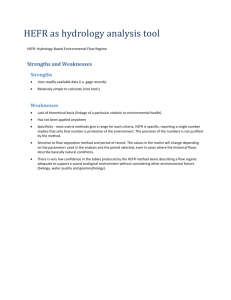
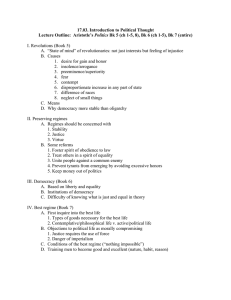
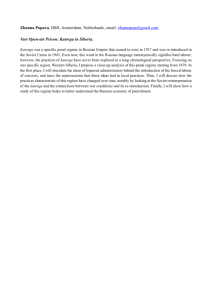
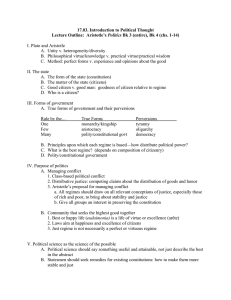
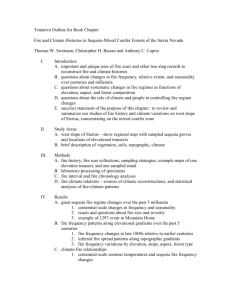
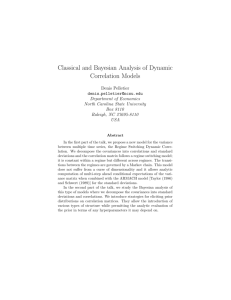
![Understanding barriers to transition in the MLP [PPT 1.19MB]](http://s2.studylib.net/store/data/005544558_1-6334f4f216c9ca191524b6f6ed43b6e2-300x300.png)
